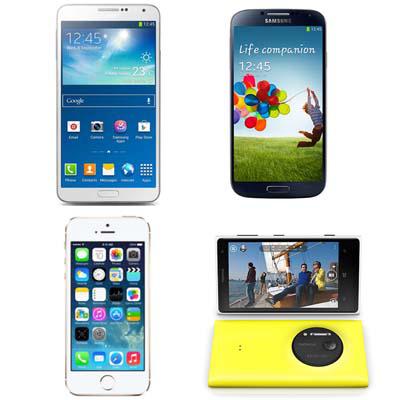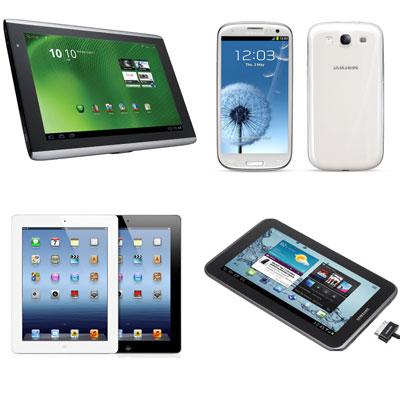Mobility Revolution: 8 Shocking Stats From Cisco's 2014 Mobile Traffic Forecast

Going Mobile
It's hard to go anywhere these days without seeing somebody, somewhere, glued to their mobile device. Smartphones and tablets have become the go-to gadgets for consumers and businesses alike and, according to Cisco, our use (and love) of mobile technology has only just begun.
The rise of wearable devices and machine-to-machine communications, for instance, are sparking a new era of mobile computing that will only add to the already enormous amounts of mobile data being generated each year. That's what Cisco expects, according to its 2014 Visual Networking Index (VNI) Global Mobile Data Traffic Forecast. The report, released this month, details mobile data trends impacting the consumer and enterprise landscapes, and contains some pretty lofty projections of what's to come as the world continues to go mobile.
Here are eight shocking stats from Cisco's forecast.

Mobile Data Explosion
Not only is mobile data traffic growing across the globe, but the pace at which it's growing is accelerating each year.
According to Cisco, mobile data traffic grew 81 percent in 2013 alone, generating 1.5 Exabytes of data per month in the latter part of the year, compared with 820 Petabyes per month by the end of 2012. In fact, mobile data traffic in 2013 was 18 times more than all traffic across the global Internet in 2000.
And, as Cisco sees it, that growth isn't going to slow anytime soon. The report says that mobile data traffic is expected to reach an annual run rate of 190 Exabytes in 2018 -- or the equivalent of every person on earth sharing 14 Instagram photos every day for a year.

Video Is Taking Off
Every year, more and more of the mobile traffic being generated comes from video, according to Cisco's report.
In 2012, video traffic accounted for half of all mobile traffic, Cisco says, and that number jumped to 53 percent in 2013. But, Cisco estimates, more than two-thirds of the world's mobile data traffic will be video by 2018, with video traffic growing 14-fold over the next five years.

Smartphones Still Reign
Despite the success of tablets and the emergence of other, wearable "smart" devices, the smartphone is still king when it comes to mobility.
According to Cisco, worldwide mobile devices and connections last year grew to 7 billion -- up from 6.5 billion in 2012 -- with smartphones accounting for 77 percent of that growth. In 2013 alone, 406 million new smartphones were connected.

iOS Devices Lead The Pack
Tablets and smartphones running Apple's iOS generated "marginally" more mobile traffic than devices running Google's Android OS by the end of 2013 in both Western Europe and North America, according to Cisco's report.
It was definitely a close race, though; Cisco's data shows that, in September 2013, for instance, iOS devices generated 1,296 Mbytes per month, while Android devices generated 1,255 Mbytes per month.

4G Fuels The Fire
As more mobile users migrate to 4G or Long-Term Evolution (LTE) technology, worldwide mobile traffic is set soar, Cisco says.
The reason is because 4G devices tend to be faster and higher-performing, meaning they encourage the use of advanced, bandwidth-hungry multimedia applications more than earlier-generation devices do. According to Cisco, 4G connections in 2013 generated 14.5 times more traffic on average than a non-4G connection. In fact, even though 4G connections represent only 2.9 percent of all mobile connections today, they already account for 30 percent of all mobile traffic.
Cisco expects mobile 4G connections to grow from 203 million in 2013 to 1.5 billion by 2018.

T he Other '1 Percent'
Traditionally, the majority of all mobile data traffic has been created by a very small group of users -- a group Cisco refers to in its report as the "top 1 percent" of mobile data subscribers. But, thanks to mobile devices and connectivity becoming more mainstream, this is no longer the case.
According to Cisco, back in 2010, the top 1 percent of mobile data subscribers accounted for more than half -- 52 percent, to be exact -- of all mobile data usage throughout the year. By 2012, that number was down to 16 percent, and, last year, fell even more to just 10 percent.

M2M Goes Mainstream
Machine-to-machine connections -- or the mobile connections between machines, objects and sensors that help enable the broader Internet of Things -- are becoming much more mainstream than perhaps some of us expected, according to Cisco.
M2M connections are projected by the networking giant to grow from 341 million in 2013 to more than 2 billion in 2018.
Adoption of wearable devices -- a subset of the M2M category -- is especially on the rise, with 22 million wearable devices being used in 2013 and generating 1.7 Petabytes of traffic a month. By 2018, Cisco expects there to be 177 million wearable devices globally.

More Devices Than People
Of all the shocking projections in Cisco's mobile traffic report, this one is the hardest to get your head around: By the end of 2014, there will be more mobile-connected devices on earth than there are people.
Specifically, Cisco expects there to be 10 billion mobile and connected devices by 2018, including those used for M2M, compared with the approximately 7.6 billion people expected to be on earth that year.